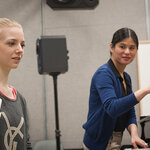Technology

A research team led by Paolo Macchiarini, MD, PhD at Karolinska Institutet in Sweden has successfully transplanted a regenerated esophagus into a rat using a bioreactor developed by Harvard Apparatus Regenerative Technology (HART), a spin-off of Harvard Bioscience. Macchiarini has previously done several successful regenerated trachea transplants in human patients using a HART bioreactor.
It has been difficult to grow tissue to replace a damaged esophagus. In humans, an esophagus is much longer and not a hollow tube like a trachea, it is instead muscly. The researchers created the…

A review of a dozen popular websites found that information on colorectal cancer is too difficult for most lay people to read and doesn't address the appropriate risks to and concerns of patients.
Sites reviewed for the study included those of the American Society for Gastrointestinal Endoscopy; American Gastroenterological Association; National Cancer Institute; Centers for Disease Control and Prevention; American College of Gastroenterology; American Society of Colon and Rectal Surgeons; Colon Cancer Alliance; and the American Cancer Society.
Most of the online patient education…

Live electronic music is an oxymoron. Clearly if you have hired Paris Hilton as a deejay, you are not hiring her because she is any sort of keen ear. If she never showed up, the music would go on.
University of British Columbia music professor Bob Pritchard has seen enough uninspiring laptop music sets to know what is wrong with the genre - backing tracks can only take you so far - and has an idea how to fix it.
Pritchard and UBC’s Laptop Orchestra believe digital cameras and other gadgets might just save live electronic music from itself - so they did a concert without actually…

In 2017, the British will introduce a new coin that should be difficult to counterfeit.
The last time a Queen Elizabeth sat on the throne they tried the same thing, to deter “divers evil persons” from damaging the reputation of English coinage and, with it, the good name of the nation. And they tried it plenty of times since. And before.
As long as there has been money, there has been counterfeiting. Today, the Royal Mint estimates retailers lose about $25 million a year due to counterfeits and up to 3% of their £1 coins are fake.
The first Queen Elizabeth inherited a coinage which…

A new tabletop display has a personal screen made from a curtain of mist. It allows users to move images around and push through the fog-screens and onto the display.
MisTable, led by Professor Sriram Subramanian and Dr Diego Martinez Plasencia from the University of Bristol’s Department of Computer Science, is a tabletop system that combines a conventional interactive table with personal screens, built using fog, between the user and the tabletop surface.
These personal screens are both see-through and reach-through. The see-through feature provides direct line of sight of the personal…

On the less glamorous side of space exploration, there's the more practical problem of waste — in particular, what to do with astronaut pee. But rather than ejecting it into space, scientists are developing a new technique that can turn this waste burden into a boon by converting it into fuel and much-needed drinking water.
Eduardo Nicolau, Carlos R. Cabrera and colleagues point out that human waste on long-term journeys into space makes up about half of the mission's total waste. Recycling it is critical to keeping a clean environment for astronauts. And when onboard water supplies run…

Four young men who have been paralyzed for years achieved groundbreaking progress — moving their legs.
Writing in the journal Brain, the researchers from the University of Louisville, UCLA and the Pavlov Institute of Physiology say the breakthrough is a result of epidural electrical stimulation of the spinal cord. All four participants were classified as suffering from chronic, motor complete spinal cord injuries and were unable to move their lower extremities prior to the implantation of an epidural stimulator. The stimulator delivers a continuous electrical current to the participants'…

Researchers have developed a system allowing neurophysiologists to share raw data with each other, something they hope will generate new discoveries in the field.
The first type of data they collected and standardized are recordings of so called ‘retinal waves’. During early development, retinal neurons generate signals that rapidly spread across from one cell to another, much like a Mexican wave in a football stadium. These patterns of activity are thought to help forge the neural connections from the eye to the brain.
To record retinal waves, scientists use multielectrode arrays (tiny…

The 2008 Mumbai terrorist attacks, where a group of gunmen killed 165 and injured 304 people, the May 2012 shooting of five people by a gunman in Seattle and the recall of four million cars by Toyota in 2009 and 2010 because of a faulty accelerator pedal show the power of social media - and the problems.
When the online community is creating and exchanging the news rather than official news channels, credibility is unknown and it can not only exaggerate the unfolding situation, but also turn it into misinformation, diverting attention from the real problems.
An analysis on the use of social…

Two things send our Uncanny Valley creepiness meter straight to red - realistic robots that flirt and anything that laughs.
Realistic laughing is actually not trivial. We see it in real life, we can often tell when someone is fake laughing. On computers it is even more off-putting. Scholars at the Numediart Institute of the University of Mons are members of a project called ILHAIRE - The Science Of Laughter, which seeks a better understanding of laughter features in order to incorporate them into interactive systems.
Stéphane Dupont, senior researcher at the circuit theory and…